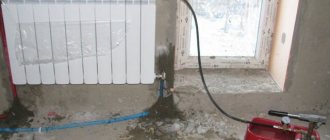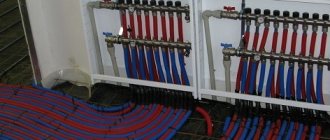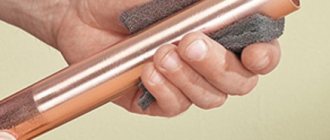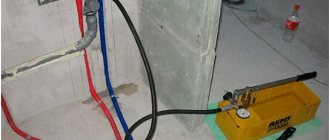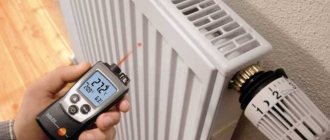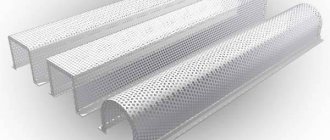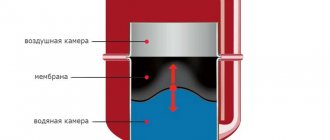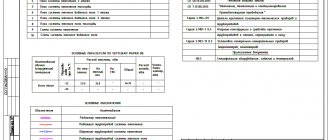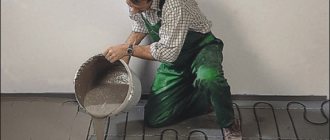Pressure testing of heating systems
Pressure testing or hydraulic testing is a test of the heating system for leaks. To do this, an excess pressure is created in it, as close as possible to the value of the maximum pressure determined by calculation.
The purpose of heating pressure testing
The main task is to simulate a situation similar to a water hammer, which can occur in an operating heating system at any time.
When is a heating system pressure tested?
The heating system is pressure tested before the start of each heating season, as well as after completion of installation and repair work. Experience shows that pressure testing of heating system pipelines allows us to identify all defects hidden during installation, and its successful implementation is the best guarantee of trouble-free operation of the equipment in the next heating season. Experienced building owners who take a responsible approach to heat supply issues conduct hydraulic tests immediately after the end of the heating season, which allows problems to be corrected in a timely manner and then a repeated hydraulic test is performed.
Typically, pressure testing of pipelines and radiators of a heating system is timed to flush the heating system and eliminate various visible problems or carry out scheduled maintenance work.
Pressure testing of the internal heating system consists of several stages
- Filling the system with water;
- Injecting pressure into it;
- Monitoring the readings of instruments measuring pressure in the system;
- Visual inspection of the presence (absence) of a leak;
- Troubleshooting in case of detection;
- Drawing up a certificate of pressure testing of the heating system.
The first stage of hydraulic testing is filling the system with water. If we are talking about a working heating system, it is stopped, cooled, and the coolant is drained.
Water is supplied to the system through a special valve, most often a ball valve, called a “drainer” and located, as a rule, in the elevator unit of the heating system or in the boiler room, on the return pipeline. Water can be supplied directly from the tap.
While filling the system with water, air is released and air pockets are removed. At the same time, they also check for leaks.
Please note that when performing pressure testing of the heating system, water is supplied only from below. If water is poured from above, there is a high probability of air entering the system and forming air pockets in it.
Pressure testing of the heating system of a country house
A characteristic feature of heating systems in private housing construction and cottages is the low level of pressure in them, usually not exceeding 2 atm. This means that to pressurize a country house, it is quite enough to supply water from the water supply to the heating system, where the pressure is exactly 2 or more atm.
In this case, you can do without additional equipment and excess pressure in the system. It is enough to simply check for leaks, fogging of the welds, or their shifts or breaks. After the test, the heating system must be immediately filled with coolant. To do this, you can use chemically purified water or antifreeze.
Features of pressure testing of the heating system of a multi-storey building
Carrying out hydraulic tests of the heating system of multi-storey residential buildings, social facilities, as well as shopping and entertainment centers is regulated by the “Rules for the technical operation of thermal power plants”, as well as the Current Sanitary Norms and Rules.
Crimping pressure
In accordance with them, before starting hydraulic tests, it is necessary to calculate the level of pressure testing . Its value depends on many factors:
- The commissioning period of the heating system (for new heating systems during pressure testing, the operating pressure is increased by 1.5-2 times, and for systems that have been in operation for several years, the operating pressure is increased by 15-50%);
- Type of heating devices installed in the building: if the system uses cast iron radiators, then the pressure test should not exceed 6 atm. For convectors, on the contrary, it is necessary to raise the pressure level to 10 atm;
- Number of floors in the building;
- Purpose of the building.
In most cases, a hydraulic test of a heating system is preceded by flushing, after which the flushing solutions are drained and the system is filled with tap water, the temperature of which should not exceed 45 C. Air must be vented.
After filling the heating system with water, a pump is connected to the drain valve (bleeder) to pressurize the heating system, with the help of which excess pressure is created in the network, the level of which is checked at the highest point of the heating system.
Maximum crimping pressure: what next?
After the system reaches the required level of pressure testing, it is held for at least 15 minutes, during which the readings of the pressure gauges are monitored, and the presence of leaks, shifts in the system or the appearance of ruptures is also visually checked.
During hydraulic tests, each heating device and component must be checked without fail. It does not matter whether the level of pressure testing remains constant or whether it drops. Hidden areas of the heating system, for example, those located in the walls or filled with screed, are especially carefully checked.
If the pressure is stable and no leaks are detected, the hydraulic test of the system is considered complete. After the test is completed, the pressure level is reset to the operating value.
If the test pressure drop exceeds the permissible parameters, a thorough examination of the system is carried out and leaks are identified. Hydraulic testing continues until the damaged area is found.
Rules and procedure for pipe crimping
Pressure testing of pipelines refers to an operation to control the integrity and quality of installation of pipes and fittings. The system is tested at elevated pressure, bordering on the permissible one. If it passes the test and maintains its tightness, then the pipeline is considered suitable for further operation.
Such tests are carried out before commissioning of new pipelines and after repair work. In addition, central heating pipelines are subjected to pressure testing before seasonal start-up. Pressure testing of plastic sewerage is mandatory after each pipe cleaning, since cleaning can damage either the pipe itself or the joint between the pipes.
To cut off the controlled section of the sewerage, pneumatic rubber plugs are used. The fixation of pipes with clamps is also checked.
Hydraulic tests are performed only with cold water to ensure work safety. Pressure testing can be carried out with compressed air, but in this case the pressure drop during a leak has to be monitored over a long period of time. Air, unlike water, is compressible.
The recommended pressure for systems of heating and water supply pipes is 6-8 kg/cm2. For main water pipelines and heating mains 10-12 kg/cm2. Cast iron sewerage is tested under pressure of no more than 2 atm. Plastic no more than 1.6 atm.
Pumps for pressure testing should be selected based on the volumes of the pipelines being tested. For a home system, a pump pumping two to three liters per minute will be sufficient. But when testing main networks, powerful circulation pumps are used, with a water flow rate of up to 150 cubic meters per hour. Such units work with pipes with a diameter of up to 1000 mm.
The crimping itself occurs as follows. The branch of the controlled pipeline is cut off from the central line of the water pipeline. To do this, shut-off valves are closed at the end and beginning of the section. Then the pressure source is connected through a special outlet provided at the design stage. Now comes the stage of pumping water or air. Injection occurs through a back pressure valve, which does not allow water to leave the system being tested. The tightness of the system is monitored by a conventional pressure gauge installed behind the back pressure valve. The pressure rises to the desired level and is controlled for a specified time. For main and industrial pipelines, the holding time under test pressure is 24 hours.
In an apartment building, pressure testing is carried out in sections, i.e. at the entrances. The set water pressure of 8 atm must be maintained for at least half an hour. If there is no leakage, then the system is considered to have passed the test. If there are leaks, they are eliminated and the pressure test is repeated.
Permissible pressure drop during pressure testing of the heating system
One of the frequently asked questions is: what pressure drop is acceptable during pressure testing?
There is a certain sequence when carrying out pressure testing in a heating system and when carrying out work in “old” heating systems it is very difficult to completely ensure tightness. A slight drop in pressure will definitely occur, and this is considered normal.
What pressure drop is acceptable?
The permissible pressure drop is specified in SNiP for pressure testing, namely:
1. When conducting hydraulic tests of heating systems with steel or panel radiators, a pressure drop is allowed for 15 minutes, the value of which does not exceed 0.01 MPa (0.1 kgf/cm2 or 0.1 Ati).
2. When hydraulic testing hot water supply systems for 10 minutes, the drop should not exceed 0.05 MPa (0.5 kgf/cm2 or 0.5 Ati).
3. When crimping systems with plastic pipelines for 30 minutes, the drop should not exceed 0.06 MPa (0.6 kgf/cm2 or 0.6 Ati).
To avoid a drop in pressure in the system, if the valves are not held in place, they resort to certain tricks by installing plugs - pancakes between the flanges of the valve.
To put the heating into operation, it is necessary to flush and pressure test the system. After completing this procedure, a certificate is filled out confirming that the installation of the heating network was done correctly. Employees authorized to perform this work are required to complete all relevant regulations.
SNiP crimping rules
The norms for pressure testing of the heating system are described in documents such as SNiP 41–01-2003, and also 3.05.01–85.
Air conditioning, ventilation and heating - SNiP 41-01-2003
Hydraulic checks of water heating systems can only be carried out at above-zero temperatures in the premises of the house. In addition, they must withstand water pressure of at least 0.6 MPa without damage to the seal and destruction.
During the test, the pressure value should not exceed the limit for the heating devices, pipelines and fittings installed in the system.
Internal sanitary systems - 3.05.01–85
According to this SNiP rule, it is necessary to check water heat supply and heating systems with the expansion vessels and boilers turned off using hydrostatic pressure equal to 1.5 working pressure, but not less than 0.2 MPa in the lower part of the system.
The heating network is considered to have passed the test if it holds the test pressure for 5 minutes and does not drop by more than 0.02 MPa. In addition, there should be no leaks in heating equipment, welds, fittings, threaded connections and pipes.
Conditions for performing crimping
Test work is carried out correctly if all necessary requirements have been met. For example, outside work cannot be carried out on the tested object, and the testing must be supervised by the shift supervisor.
Pressure testing is carried out only according to a program approved by the company’s chief engineer. It defines: the procedure for employees and the technological sequence of verification . They also outline safety measures for ongoing and current work performed at adjacent facilities.
There should be no strangers during pressure testing of the heating system; there should be no turning on or off of testing devices; only employees taking part in the test remain on site.
When work is carried out in adjacent areas, it is imperative to provide reliable fencing and turn off the testing equipment.
Inspection of heating appliances and pipes is permitted only at operating pressure values. When the heating system is pressure tested, reports are filled out to confirm the tightness.
Crimping procedure
This method of checking the heating system involves performing hydraulic tests:
- Heat exchangers;
- Boilers;
- Pipe
This makes it possible to identify leaks that indicate depressurization of the network.
Before testing the heating system with plugs, you should isolate the heating system from the water supply, visually assess the reliability of all connections , and also check the functionality and condition of the shut-off valves.
After this, the expansion tank and boiler are turned off to flush the radiators and pipelines from various deposits, debris and dust.
During the hydraulic test, the heating system is filled with water, but during air tests this is not done, but simply a compressor is connected to the drain valve. Then the pressure is increased to the required value, and its indicators are monitored with a pressure gauge. If there are no changes, then the tightness is good, therefore the system can be put into operation.
When the pressure begins to decrease beyond the permissible value, it means that defects are present . Leaks in a filled system are not difficult to find. But in order to identify damage during an air test, a soap solution should be applied to all joints and joints.
Air pressure testing takes at least 20 hours, and hydraulic testing takes 1 hour.
Having corrected the identified defects, the procedure is repeated again, and this must be done until good tightness is achieved . After carrying out this work, pressure testing certificates for heating systems are filled out.
Checking the heating network with air is usually carried out if it is impossible to fill it with water, or when working in low temperature conditions, because the liquid can simply freeze.
Permissible test pressure when testing water heating
Many developers are interested in what pressure should be used to check the heating system. In accordance with the SNiP requirements presented above, during pressure testing, pressure is allowed to be 1.5 times higher than the working pressure , but it should not be less than 0.6 MPa.
There is another figure indicated in the “Rules for the technical operation of thermal power plants.” Of course, this method is “softer”; its pressure exceeds the working pressure by 1.25 times.
In private houses equipped with autonomous heating, it does not rise above 2 atmospheres, and it is adjusted artificially: if excess pressure appears , the relief valve immediately turns on. Whereas in public and multi-apartment buildings the working pressure is much higher than these values: five-story buildings - about 3-6 atmospheres, and tall buildings - about 7-10.
Heating system testing equipment
Most often, a pressure tester is used to perform a hydraulic test. It is connected to the circuit to regulate the pressure in the pipes.
Crimping rules
Based on the regulatory documentation given below, a pressure testing certificate has been developed, which is one of the main documents when handing over work to the Customer at the site.
Heating networks must undergo annual hydraulic tests for strength and density (pressure tests) to identify defects after the end of the heating season and carry out repair work. Pressure testing of pipelines accessible for inspection during operation may be performed once after completion of installation.
Hydraulic pressure testing is carried out with a test pressure of 1.25 working pressure, but not less than 1.6 MPa (16 kgf/cm2). The pipelines are maintained under test pressure for at least 5 minutes, after which the pressure is reduced to operating pressure. At operating pressure, a thorough inspection of pipelines is carried out along their entire length. The results of pressure testing are considered satisfactory if during its implementation there is no drop in pressure and no signs of rupture, leakage or fogging are found in valve bodies and seals, in flange connections, etc.
Before the start of the heating season, after completion of repairs, heating and hot water supply systems must be subjected to hydraulic pressure testing for strength and density:
• elevator units, heaters and water heaters for heating and hot water supply - pressure 1.25 working, but not lower than 1 MPa (10 kgf/cm2);
• heating systems with cast iron heating devices - pressure 1.25 working, but not more than 0.6 MPa (6 kgf/cm2);
• panel and convector heating systems – pressure 1 MPa (10 kgf/cm2);
• hot water supply systems - pressure equal to the working pressure in the system plus 0.5 MPa (5 kgf/cm2), but not more than 1 MPa (10 kgf/cm2).
The hydraulic test must be carried out at positive outside temperatures. When the outside air temperature is below zero, checking the density is possible only in exceptional cases.
Systems are considered to have passed the test if, during testing:
• no “sweating” of welds or leaks from heating devices, pipelines, fittings and other equipment were detected;
• when testing water and steam heat consumption systems for 5 minutes. the pressure drop did not exceed 0.02 MPa (0.2 kgf/cm2);
• when testing surface heating systems, the pressure drops within 15 minutes. did not exceed 0.01 MPa (0.1 kgf/cm2);
• when testing hot water supply systems, the pressure drops within 10 minutes. did not exceed 0.05 MPa (0.5 kgf/cm2).
The results of the inspection are documented in a test certificate. If the results of pressure testing do not meet the specified conditions, it is necessary to identify and eliminate leaks, and then recheck the tightness of the system. During hydraulic testing, spring pressure gauges must be used with an accuracy class of at least 1.5, with a body diameter of at least 160 mm, a scale for a nominal pressure of about 4/3 of the measured pressure, a division value of 0.01 MPa (0.1 kgf/cm2), verified and sealed by the state verifier.
How the heating system is pressurized SNIP - the sequence of work
Before commissioning the heating system, a number of certain measures must be carried out. The system is flushed and pressure tested; the result of the work performed is a certificate that confirms that the installation work was completed correctly. This document and other necessary documents are filled out by specialists who are authorized to carry out these activities. In order to carry out verification work yourself, it is important to understand what pressure testing of a heating system means.
How to carry out crimping correctly
Pressure testing of heating systems is carried out in accordance with the requirements of certain documents, which indicate what pressure is used to pressurize the heating system. In particular, we are talking about Sanitary Standards and Rules numbered 41-01-2003 (air conditioning, ventilation and heating) and 3.05.01-85 (Internal sanitary systems).
According to SNIP 41-01-2003, pressure testing of the heating system is carried out only if the room temperature is above 00C. In addition, the system must withstand a pressure of the working medium of at least 0.6 MPa, while damage and leakage are not allowed.
Pressure testing is carried out under pressure, the value of which does not exceed the limit values for heating devices, pipelines and fittings built into the system.
In order not to violate SNIP 3.05.01-85, before checking water heating systems, expansion vessels and boilers should be turned off. According to SNIP, the pressure during pressure testing of the heating system should be 1.5 times higher than the operating pressure, but not less than 0.2 MPa at the lower level of the system.
For a positive test result, the network must last about 5 minutes under the recommended test pressure, and its value should decrease by no more than 0.02 MPa. Also, during a visual inspection of the system elements, no leaks should be detected in threaded connections and welds, pipes and fittings, heating devices and other equipment.
Requirements for crimp testing
A heating system inspection can only be considered completed if certain requirements are met:
- All tests are carried out under the strict supervision of the shift supervisor.
- During control activities, it is prohibited to perform any work at the site.
- The testing program must be approved by the chief engineer of the testing organization. The program strictly regulates the actions of each employee and the sequence of the technological process. In addition, it outlines safety measures when carrying out inspection activities and scheduled work at adjacent facilities.
- The presence of strangers at the site during pressure testing of the heating system is not allowed. Only specialists directly involved in the inspection should be on site.
- It is prohibited to enable or disable the object being checked.
- During testing, adjacent areas must be fenced off with special structures, and the testing equipment must be turned off.
- During the inspection of the equipment being tested, the operating pressure must be maintained in the system; exceeding these values is not allowed.
- To confirm the tightness of the water heating system, the responsible specialist draws up a report on the performance of pressure testing.
How to correctly draw up a pressure test report for a heating system
To draw up an act according to all the rules, it is important to indicate in it the following:
- Test method used.
- The project according to which the installation and installation of the test object was carried out.
- Date and address of testing events.
- List of persons whose signature must be on the document. In most cases, the property owners and representatives of service organizations are indicated.
- Methods for eliminating identified defects.
- Test results.
- Presence of signs of depressurization of the system or violation of threaded connections and welds. It should also be noted that there is condensation on the surface of pipes and fittings.
Permissible pressure standards when performing pressure testing work
When performing hydraulic pressure testing of a heating system, it is important to comply with the requirements of SNIP regarding test pressure. In particular, the document says that the test pressure should exceed the operating values by approximately 1.5 times, but not less than 0.6 MPa.
According to another document, “Rules for the technical operation of thermal power plants,” the pressure can exceed the permissible standards by 1.25 times.
Autonomous heating in private houses does not exceed 2 atmospheres, otherwise the pressure relief valve is triggered.
Equipment for crimping
Hydraulic tests are carried out using a pressure tester, which is connected to the system to regulate pressure.
Heating in private homes can be checked with a manual pressure tester, since these systems do not require high pressure for testing. Such devices are capable of developing a force of 60 bar and higher; such values make it possible to test water heating systems in multi-storey buildings.
Manual devices have the following advantages:
- A price affordable for most consumers.
- Small weight and dimensions of the device. Thanks to this, they can be used both for personal interests and in the professional sphere.
- Long service life.
- Ability to check medium and small heating appliances.
It is recommended to check systems of multi-storey buildings and industrial facilities using electrical instruments. This equipment supplies water to the system at high pressure, up to 500 bar, which is inaccessible to manual devices.
Electric pumps can be built into or connected to a pipeline. In most cases, the hose is connected to a tap through which water is supplied to the system.
Crimping procedure
This method of checking the heating system involves performing hydraulic tests:
- Heat exchangers;
- Boilers;
- Pipe
This makes it possible to identify leaks that indicate depressurization of the network.
Before testing the heating system with plugs, you should isolate the heating system from the water supply, visually assess the reliability of all connections , and also check the functionality and condition of the shut-off valves.
After this, the expansion tank and boiler are turned off to flush the radiators and pipelines from various deposits, debris and dust.
During the hydraulic test, the heating system is filled with water, but during air tests this is not done, but simply a compressor is connected to the drain valve. Then the pressure is increased to the required value, and its indicators are monitored with a pressure gauge. If there are no changes, then the tightness is good, therefore the system can be put into operation.
When the pressure begins to decrease beyond the permissible value, it means that defects are present . Leaks in a filled system are not difficult to find. But in order to identify damage during an air test, a soap solution should be applied to all joints and joints.
Air pressure testing takes at least 20 hours, and hydraulic testing takes 1 hour.
Having corrected the identified defects, the procedure is repeated again, and this must be done until good tightness is achieved . After carrying out this work, pressure testing certificates for heating systems are filled out.
Checking the heating network with air is usually carried out if it is impossible to fill it with water, or when working in low temperature conditions, because the liquid can simply freeze.
What pressure is the heating system tested at?
To put the heating into operation, it is necessary to flush and pressure test the system. After completing this procedure, a certificate is filled out confirming that the installation of the heating network was done correctly. Employees authorized to perform this work are required to complete all relevant regulations.
Pressure testing of heating systems
High-quality operation of heating systems with high levels of energy efficiency and the reliability of this work depend not only on competent design and high-quality installation work, but also on carefully carried out commissioning: pressure testing and washing.
Why hydrotest?
As you know, the heating system is a closed circuit operating under excess pressure. Any leaks in the threaded connections of the fittings or at the connection points of radiators will lead to water leakage, flooding of premises, damage to building structures, finishing, etc.
Source: https://gscomplect.com/kakim-davleniem-ispytyvaetsya-sistema-otopleniya/
Norm of pressure drop during crimping - For both hands master
Before commissioning the heating system, a number of certain measures must be carried out.
The system is flushed and pressure tested; the result of the work performed is a certificate that confirms that the installation work was completed correctly.
This document and other necessary documents are filled out by specialists who are authorized to carry out these activities.
In order to carry out verification work yourself, it is important to understand what pressure testing of a heating system means.
Pressure testing of the heating system
Ask a Question
Want to know more about the service? —ask us!
Pressure testing of a heating system refers to hydraulic tests carried out to check the integrity of structural elements and the tightness of connections between them.
Why are pressure testing and flushing of the heating system carried out?
The operation of central heating systems and autonomous heating networks of private houses is associated with inevitable wear and degradation of pipelines, radiators and other elements of the complex. If hydraulic tests are necessary to identify malfunctions and their subsequent elimination, then flushing is performed to remove internal corrosion products, deposited scale and other obstacles to the normal circulation of coolant from radiators and pipes.
Both events are carried out as part of the preparation of internal networks for the heating season. Pressure testing is also necessary to check the performance of heating systems after their repair or installation.
Hydraulic test regulations
The most complete standards for performing pressure testing are described in the industry Rules for the operation of power plants N 115 of 2003, approved by the Ministry of Fuel and Energy of the Russian Federation.
Here are the main provisions according to the document:
- The inspection must be carried out at least once a year;
- The minimum test pressure should be 1.25 of the working pressure, but not less than 2 atm;
- Thermal units/points (TP) are tested by hydrostatic influence of 10 atm, internal networks with cast iron and steel stamped radiators - 6 atm, convectors and panel-type heat exchangers - 10 atm;
- A general rule for all types of radiators: the test pressure must correspond to the data specified by the manufacturer;
- The test is considered successfully passed if no visible leaks or sweating are detected, and the pressure drop is no more than 0.5 atm after 10 minutes for metal radiators and 0.6 atm after 30 minutes for plastic pipes;
- If damage and leaks are detected, the necessary repair work is carried out, after which the tests are repeated.
Procedure for crimping and washing
When testing internal networks, the following sequence of operations is observed:
- They begin to carry out crimping from the thermal unit (point). Pressure is shut off and applied to the transformer substation equipment to identify possible leaks in fittings, devices, and pumps;
- Before crimping, a visual inspection is carried out, connections are tightened and any detected faults are eliminated;
- During pressure testing of the heating system, the pressure is selected depending on the type of radiators installed in the building. The equality of the pressure gauges on the forward and reverse flow indicates the absence of leaks;
- After a test run and recording a drop in pressure gauge readings, which should not exceed permissible values, the pressure is reduced to operating pressure. After this, the network is inspected;
- If the test result is positive, a corresponding official report is drawn up.
Transformer substations and internal networks in the central heating system are tested during the period from May to October during the preparatory period. for the heating season. It is technically possible to conduct local tests in winter. Such a need may arise after installation or reconstruction of individual sections of the internal network, for example, when replacing heating radiators in a separate apartment.
It is recommended to flush the heating system immediately after the end of the heating season. The most effective way is pumping hydropneumatic pulp (a mixture of water and air). The mixing of air with water is ensured by opening the corresponding valves for suction. The operation is carried out in two directions - along the supply and return lines. Thus, there are no “dead zones” left in the radiators that are inaccessible for flushing.
The best results can be achieved if you wash the nets regularly. To do this, during the operation of the elevator for discharge, one of the paired risers is opened one at a time (if the house has a bottom supply scheme). In houses with top supply, the risers are alternately blocked.
Pressure testing of autonomous heating systems in private homes has a number of features. First, smaller test pressures are used. Secondly, tests of underfloor heating systems mounted on the basis of plastic pipes are carried out immediately before pouring the final concrete screed. This is done to ensure that all elements of the heated floor distribution are fixed in positions corresponding to the applied hydraulic pressure. This reduces the amount of mechanical stress on the pipes during operation.
